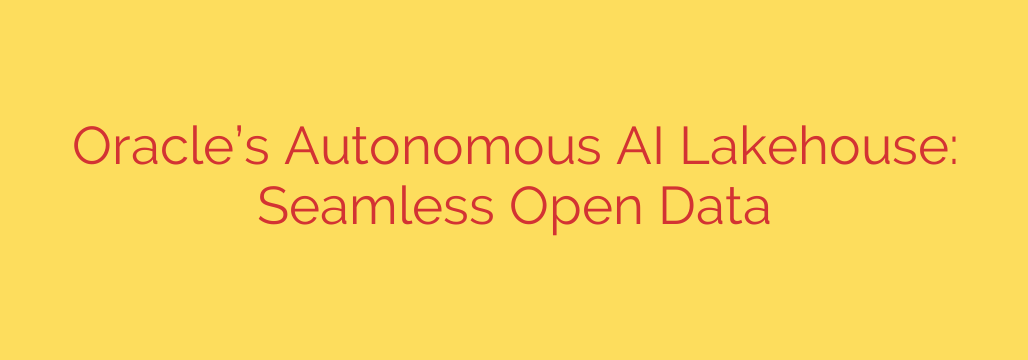
The Future of Data is Here: How the Oracle AI Lakehouse Unifies Analytics and AI
Businesses today are sitting on a goldmine of data, but for many, it remains frustratingly out of reach. Information is often trapped in separate silos—transactional data in one database, IoT streams in another, and unstructured files like documents and images stored elsewhere. This fragmentation makes it nearly impossible to get a complete picture, slowing down insights and hindering the development of powerful AI applications.
The challenge has always been to bring these disparate worlds together without creating more complexity. The solution lies in a modern data architecture known as the lakehouse, and Oracle is pushing its capabilities to new heights with its Autonomous AI Lakehouse. This platform is designed to break down data barriers, providing a single, unified environment for all your data analytics and AI needs.
What is a Data Lakehouse?
To understand the innovation, it’s helpful to quickly define the core concept. A data lakehouse combines the best features of two traditional architectures:
- Data Lakes: Vast, cost-effective repositories for storing massive amounts of raw, unstructured data in its native format (like logs, images, and sensor data).
- Data Warehouses: Highly structured systems optimized for fast and complex business intelligence (BI) queries on processed data.
Historically, organizations had to move and duplicate data between these two systems, a process that was slow, expensive, and created governance headaches. A lakehouse architecture eliminates this by building data warehousing capabilities directly on top of the open, low-cost storage of a data lake. This creates a single source of truth for all data types, from structured to unstructured.
The Oracle AI Lakehouse: Unifying Data with Intelligence
The Oracle AI Lakehouse builds on this foundation by integrating powerful artificial intelligence and autonomous capabilities, creating a seamless and intelligent data platform. It allows organizations to store, manage, and analyze all their data without having to move it, dramatically simplifying their data architecture.
Key features that set this approach apart include:
Seamless Support for Open Data Formats: A major advantage is its native support for open-source data formats. Whether your data is in Parquet, Avro, Delta Lake, or Iceberg, the platform can query it directly in object storage. This eliminates the need for complex data movement and proprietary formatting, ensuring your data remains open and accessible for any tool or application.
Autonomous Operations: Powered by the Oracle Autonomous Database, the platform automates management tasks like provisioning, scaling, tuning, and security patching. This drastically reduces administrative overhead, frees up your technical teams to focus on innovation, and lowers the total cost of ownership.
Integrated AI and Machine Learning: This isn’t just a storage platform; it’s a launchpad for innovation. The AI Lakehouse includes a rich set of AI and machine learning tools built directly into the database engine. Data scientists can build, train, and deploy ML models using their preferred languages and frameworks right where the data lives, accelerating the path from model to production.
Key Business Benefits of a Unified Approach
Adopting a unified data platform like the Oracle AI Lakehouse translates directly into tangible business advantages. By centralizing data and analytics, organizations can:
Accelerate Insights: With all data available in one place, analysts can run queries that combine structured business data with unstructured data from the lake. This provides a 360-degree view, unlocking deeper insights that were previously impossible to uncover.
Simplify Data Architecture: A single, unified platform means fewer moving parts. This reduces the complexity of your data pipelines, minimizes data duplication, and lowers the risk of inconsistencies, leading to more reliable and trustworthy analytics.
Boost AI and ML Development: By removing the barriers between data storage and AI tooling, data science teams can work more efficiently. They spend less time on data preparation and more time developing models that can predict customer behavior, optimize supply chains, or detect fraud in real-time.
Enhance Security and Governance: Managing security across dozens of data silos is a significant challenge. A centralized lakehouse makes it far easier to implement consistent security policies, manage access controls, and track data lineage. This ensures your data is not only accessible but also secure and compliant with regulations.
Actionable Security Tips for Your Data Lakehouse
As you centralize your data, maintaining robust security is paramount. Here are a few best practices to implement:
- Implement Unified Access Control: Use a role-based access control (RBAC) model to ensure users can only access the data they are authorized to see. Centralizing this control prevents security gaps that can occur in fragmented systems.
- Leverage Autonomous Security Features: Take full advantage of built-in security tools. Enable features like automatic threat detection, transparent data encryption, and data masking to protect sensitive information both at rest and in transit.
- Establish Strong Data Governance: Just because data is in an open format doesn’t mean it should be a free-for-all. Use data catalogs to document metadata, track data lineage, and enforce quality rules to ensure your data remains a reliable asset.
By embracing a unified, open, and intelligent data platform, your organization can finally unlock the full potential of its data assets, driving smarter decisions and fostering a new wave of data-powered innovation.
Source: https://datacenternews.asia/story/oracle-unveils-autonomous-ai-lakehouse-for-seamless-open-data








